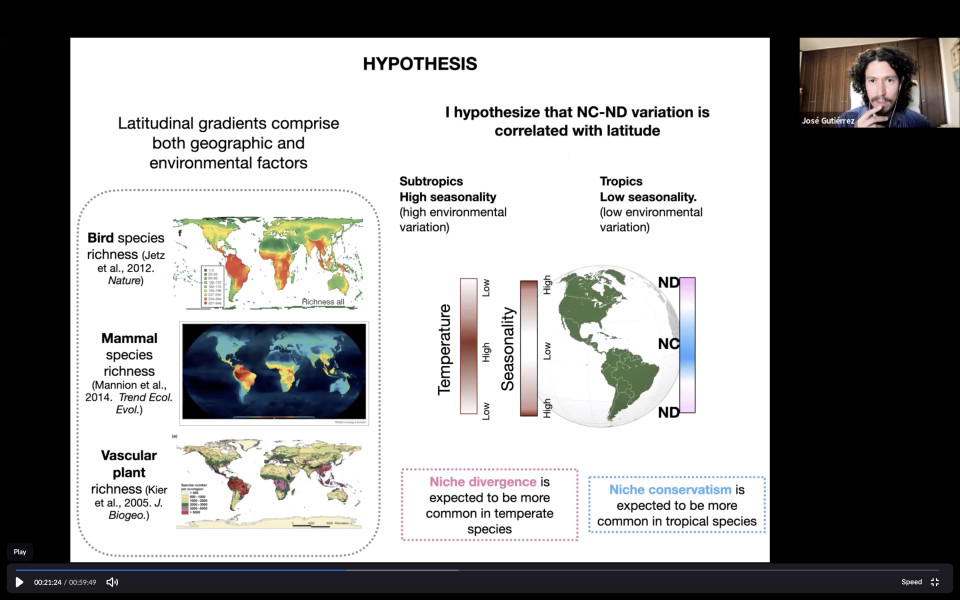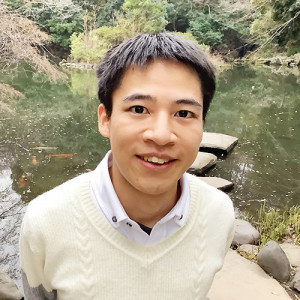Volume 203
Back to Newsletter List
Seminar Report
iTHEMS Biology Seminar by Dr. José Said Gutiérrez-Ortega on June 2, 2022
2022-06-09
In this talk, I mentioned how both geographic isolation and natural selection may influence the way how species can be originated. I made emphasis in a general pattern that suggests that tropical species are more likely than high-latitude species to evolve while retaining the niche of their ancestors; a process called “niche conservatism”. To demonstrate this pattern, I showed the recent results of my own empirical research on the cycad genus Ceratozamia from Mexico: species at lower latitudes evolved niches less differentiated than expected from a Brownian Motion model (an evidence of niche conservatism), and high-latitude species evolved niches more differentiated than expected (an evidence of niche divergence). I hypothesize that both “niche conservatism” and “niche divergence” are not opposed processes as usually thought in ecology, but are part of a same general process. The implementation of models to predict how phylogenetic and ecological factors interplay in the formation of species along the latitudinal gradient may explain the pattern at the global level. The discussion on this topic allowed identifying that the latitude-associated variation of biodiversity richness seems to be analogous to thermodynamic models: a higher energy availability in the tropics will make biological groups to evolve different ways (species) to exploit that energy.
Reported by José Said Gutiérrez-Ortega
Upcoming Events
Seminar
Quantum Matter Seminar
Topological aspects of non-Hermitian physics
June 21 (Tue) 16:00 - 17:15, 2022
Nobuyuki Okuma (Assistant Professor, Yukawa Institute for Theoretical Physics, Kyoto University)
The past decades have witnessed an explosion of interest in topological materials, and a lot of mathematical concepts have been introduced in condensed matter physics. Among them, the bulk-boundary correspondence is the central topic in topological physics, which has inspired researchers to focus on boundary physics. Recently, the concepts of topological phases have been extended to non-Hermitian Hamiltonians, whose eigenvalues can be complex. Besides the topology, non-Hermiticity can also cause a boundary phenomenon called the non-Hermitian skin effect, which is an extreme sensitivity of the spectrum to the boundary condition. In this talk, I will explain recent developments in non-Hermitian topological physics by focusing mainly on the boundary problem. As well as the competition between non-Hermitian and topological boundary phenomena, I will discuss the topological nature inherent in non-Hermiticity itself.
Field: condensed matter physics
Keywords: topological materials, non-Hermitian systems, skin effect, bulk-boundary correspondence
Venue: via Zoom
Event Official Language: English
Seminar
iTHEMS Theoretical Physics Seminar
Dress code for infrared safe S-matrix in QED
June 22 (Wed) 13:30 - 15:00, 2022
Sotaro Sugishita (Designated Assistant Professor, Institute for Advanced Research (IAR), Nagoya University)
We consider the infrared (IR) aspects of the gauge invariant S-matrix in QED. I will review the problem of IR divergences in QED, and introduce the dressed state formalism to obtain IR-safe S-matrix elements. I will show a condition for dressed states to obtain IR-safe S-matrix elements, and explain that this condition can be interpreted as the memory effect and is related to asymptotic symmetry. I also explain that IR divergences are necessary to prohibit the violation of asymptotic symmetry. We also argue that the difference between dressed and undressed states can be observed, even if we are able to observe an inclusive cross-section summing over soft photons.
Venue: Hybrid Format (Common Room 246-248 and Zoom)
Event Official Language: English
Seminar
iTHEMS Theoretical Physics Seminar
Gradient flow exact renormalization group 1
July 5 (Tue) 13:30 - 17:00, 2022
Hiroshi Suzuki (Professor, Graduate School of Science, Kyushu University)
Wilson’s exact renormalization group (ERG), which tells how a system changes under the scale transformation, provides a fundamental framework to define quantum field theory even beyond the perturbation theory. It has however been known that it is difficult to preserve a manifest gauge symmetry in ERG because of the usage of the momentum cutoff in ERG. Here, we propose a possible modification of ERG, the gradient flow exact renormalization (GFERG), which preserves a manifest gauge symmetry being based on a gauge-covariant diffusion equation. I explain the basic idea and properties of GFERG. If time permits, I want to present a possible application of GFERG to the consideration of the axial anomaly.
Venue: via Zoom
Event Official Language: English
Seminar
iTHEMS Theoretical Physics Seminar
Gradient flow exact renormalization group 2
July 6 (Wed) 13:30 - 17:00, 2022
Hiroshi Suzuki (Professor, Graduate School of Science, Kyushu University)
Wilson’s exact renormalization group (ERG), which tells how a system changes under the scale transformation, provides a fundamental framework to define quantum field theory even beyond the perturbation theory. It has however been known that it is difficult to preserve a manifest gauge symmetry in ERG because of the usage of the momentum cutoff in ERG. Here, we propose a possible modification of ERG, the gradient flow exact renormalization (GFERG), which preserves a manifest gauge symmetry being based on a gauge-covariant diffusion equation. I explain the basic idea and properties of GFERG. If time permits, I want to present a possible application of GFERG to the consideration of the axial anomaly.
Venue: via Zoom
Event Official Language: English
Seminar
Information Theory Seminar
Speed limits for macroscopic transitions
July 13 (Wed) 13:30 - 15:00, 2022
Ryusuke Hamazaki (RIKEN Hakubi Team Leader, Nonequilibrium Quantum Statistical Mechanics RIKEN Hakubi Research Team, RIKEN Cluster for Pioneering Research (CPR))
Speed of state transitions in macroscopic systems is a crucial concept for foundations of nonequilibrium statistical mechanics as well as various applications in quantum technology represented by optimal quantum control. While extensive studies have made efforts to obtain rigorous constraints on dynamical processes since Mandelstam and Tamm, speed limits that provide tight bounds for macroscopic transitions have remained elusive. Here, by employing the local conservation law of probability, the fundamental principle in physics, we develop a general framework for deriving qualitatively tighter speed limits for macroscopic systems than many conventional ones. We show for the first time that the speed of the expectation value of an observable defined on an arbitrary graph, which can describe general many-body systems, is bounded by the “gradient” of the observable, in contrast with conventional speed limits depending on the entire range of the observable. This framework enables us to derive novel quantum speed limits for macroscopic unitary dynamics. Unlike previous bounds, the speed limit decreases when the expectation value of the transition Hamiltonian increases; this intuitively describes a new trade-off relation between time and the quantum phase difference. Our bound is dependent on instantaneous quantum states and thus can achieve the equality condition, which is conceptually distinct from the Lieb-Robinson bound. We also find that, beyond expectation values of macroscopic observables, the speed of macroscopic quantum coherence can be bounded from above by our general approach. The newly obtained bounds are verified in transport phenomena in particle systems and nonequilibrium dynamics in many-body spin systems. We also demonstrate that our strategy can be applied for finding new speed limits for macroscopic transitions in stochastic systems, including quantum ones, where the bounds are expressed by the entropy production rate. Our work elucidates novel speed limits on the basis of local conservation law, providing fundamental limits to various types of nonequilibrium quantum macroscopic phenomena.
Reference
- Ryusuke Hamazaki, Speed Limits for Macroscopic Transitions, PRX Quantum 3, 020319 (2022), doi: 10.1103/PRXQuantum.3.020319
Venue: Hybrid Format (Common Room 246-248 and Zoom)
Event Official Language: English
Seminar
NEW WG Seminar
Superconducting-like heat current: Effective cancellation of current-dissipation trade-off by quantum coherence
July 25 (Mon) 13:30 - 15:00, 2022
Tajima Hiroyasu (Assistant Professor, Graduate School of Informatics and Engineering, The University of Electro-Communications)
Recent developments in statistical mechanics have revealed a tradeoff between heat current and dissipation [1,2]. In various situations, this current-dissipation tradeoff represents a relationship between thermal energy flow and entropy increase, similar to Joule’s law W=RI^2.
On the other hand, the coherence effect on the current-dissipation tradeoff has not been thoroughly analyzed. Here, we systematically analyze how coherence affects the current-dissipation tradeoff [3]. The results can be summarized in the following three rules:
- Quantum coherence between different energy levels strengthens the trade-off. In other words, the ratio between the square of the heat current and the entropy production ratio corresponding to electrical resistance R (hereafter referred to as "thermal resistance") is increased by the superposition of different energy levels.
- Coherence between degeneracies weakens the trade-off. That is, thermal resistance is weakened by coherence between degeneracies.
- With enough coherence between degeneracies, we can cancel the trade-off effectively and make the thermal resistance approximately zero. Then, macroscopic heat flow without entropy increase is realized.
These three results directly reveal the coherence effects on heat engine performance. That is, coherence between different energy levels reduces the performance, while coherence between degeneracies increases it. And when there is a sufficient amount of coherence between degeneracies, the efficiency can asymptotically reach the Carnot efficiency (η=η_{Car}-O(1/N)) while the power is O(N).
References
- N. Shiraishi, K. Saito, H. Tasaki, Universal Trade-Off Relation between Power and Efficiency for Heat Engines, Phys. Rev. Lett. 117, 190601 (2016), doi: 10.1103/PhysRevLett.117.190601
- A. C. Barato, U. Seifert, Thermodynamic Uncertainty Relation for Biomolecular Processes, Phys. Rev. Lett. 114, 158101 (2015), doi: 10.1103/PhysRevLett.114.158101
- H. Tajima, K. Funo, Superconducting-like Heat Current: Effective Cancellation of Current-Dissipation Trade-Off by Quantum Coherence, Phys. Rev. Lett. 127, 190604 (2021), doi: 10.1103/PhysRevLett.127.190604
Venue: via Zoom
Event Official Language: English
Workshop
DM3 - Deep insights and Multiple strategies for Deciphering the Mystery of Dark Matter
September 15 (Thu) - 17 (Sat) 2022
Venue: SUURI-COOL (Kobe), Room S704-S705, Integrated Innovation Building (IIB), Kobe Campus, RIKEN / via Zoom
Event Official Language: English
Paper of the Week
Week 3, June 2022
2022-06-16
Title: Reflected Entropy in Boundary/Interface Conformal Field Theory
Author: Yuya Kusuki
arXiv: http://arxiv.org/abs/2206.04630v1
If you would like to cancel your subscription or change your email address,
please let us know via our contact form.
Copyright © iTHEMS, RIKEN. All rights reserved.





